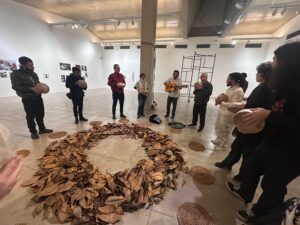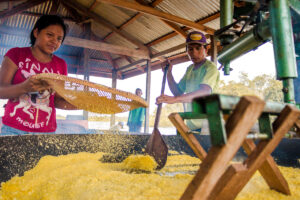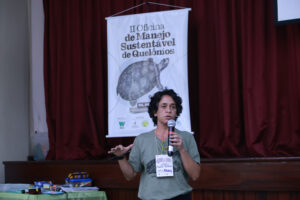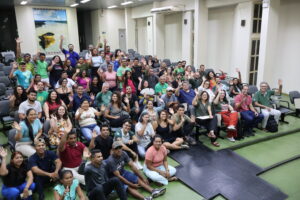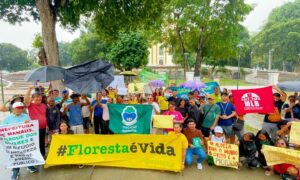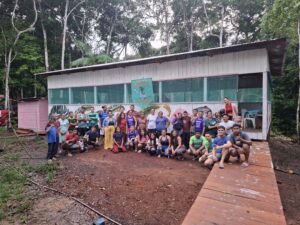By: Maria Cunha
Translated by Luiza Campos
The festivities of popular culture are living expressions of a people’s identity. They transcend the act of celebration, serving as spaces of memory, resistance, and the transmission of ancestral knowledge. Rooted in traditions, beliefs, and collective practices, these expressions reflect the cultural diversity of regions, communities and social groups. Festas juninas (a traditional Brazilian festival held in June), congados (Afro-Brazilian tradition that syncretizes African worship practices and popular Catholic traditions), maracatus (religious, cultural, and musical expression movement with an Afro-Indigenous origin), folias de reis (a Brazilian festival celebrating the Three Wise Men), bumba meu boi (an Afro-Indigenous Brazilian celebration centered around the a folkloric tale of a bull), carimbó (a traditional Brazilian dance and music style from the Amazon region), frevo (a Brazilian dance and music style from Pernambuco state), and so many other festivities are examples of the cultural richness of Brazil. Each one carries symbols, rhythms, dances, clothing, and narratives that trace back from stories of encounters and mismatches between native people and the diverse people that inhabit these lands.
These celebrations are not only moments of leisure; they are political and social acts that reaffirm identities and promote community organization and territorial belonging. They strengthen bonds, preserve culinary traditions and ways of living, serving as a link between the past and the present. In a world increasingly globalized, where there is the risk of cultural homogenization, valuing and protecting popular cultural festivities is essential. They remind us of the importance of diversity, collective creativity and human capacity for reinventing daily life through art and tradition. The popular culture festivities in local communities of Mid-Juruá are more than simple celebrations; they are rich and complex manifestations that express the identity, beliefs, values and history of a people. Several of these celebrations have profound roots, connecting current generations with the traditions of their ancestors. They play a vital role in the preservation of cultural heritage, offering a space for experiencing and transmitting local practices and knowledge.

These festivities may have different forms and meanings, depending on the regional context. One of the main aspects is the community and participatory character. It is not just an individual celebration, but a collective one, in which the union of the people strengthens social and cultural bonds. Each event is an opportunity to reinforce the connection between the people, the land, nature and the spiritual and popular imagery elements that compose the local cosmovision.
Among the most common are the religious celebrations, known in the region as “festejos”, which are usually held in tribute to saints, or significant events of the christian calendar, although they may also have indigenous origin. The religious celebrations, such as festivities honoring patron saints, are characterized by rituals involving processions, masses, hymns and other expressions of faith. But many of these celebrations bring to light cultural aspects beyond religiosity, such as dances, music and traditional foods that reveal the rich cultural diversity of each region.


Left photo: Lunch from the festivity honoring São Raimundo, in the São Raimundo community. Right photo: a meal during the community festivity. Photos: Rodrigo Pires
“The festejo is a tribute we pay to the saint in gratitude and to strengthen our faith, so that we may have more health and prosperity in the community. It always takes place when the community is named after a saint, or when some resident has made a promise to the saint; and, in gratitude for the received blessing, we also offer the festejo” Francisca Moura da Cunha – Comunidade São Raimundo.
Some references to saint festejos, such as these, can be seen along the river in different communities: São Raimundo, São Sebastião, São Francisco das Chagas, São Lázaro, São José, São Pedro, Nossa Senhora da Conceição, São Brás – these are some of the name celebrated in the region.
The saint festejos in traditional communities are vibrant expressions of faith, culture and collective identity. Rooted in a mixture of religious traditions and popular knowledge, these events go far beyond the spiritual aspect, representing moments of strengthening community bonds and celebration of life moments. They are usually holidays that embody respect and collaboration of all.
Each community has its patron saints, and the festejos are organized with great dedication. Preparations begin weeks in advance, with the decoration of chapels (churches) and community spaces , the organization of processions and novenas, and the planning of cultural activities. The festivities are marked by masses, singing, traditional dances, conversation circles and the sharing of typical foods, such as beiju, tapioca, macaxeira (cassava), baked fish, farm-raised or free-range chicken, cortadinho de porco (pork stew), and the traditional and most famous batido de tartaruga (turtle stew). These organizations, both of the dishes and the decoration of the spaces, are usually led by women; even though men also collaborate, it is them who are in charge.
These cultural manifestations are essential for strengthening local identity. They not only celebrate what it is, but also teach younger generations about the importance of their roots and history. In times of globalization, when local cultures are at risk of being diluted, popular festivities become a space of cultural resistance, preservation and renewal. Additionally, they play an inclusive role, bringing together people from different generations, social classes and ethnicities around a common goal: to celebrate life and the traditions that make them unique.
The community aspect is one of the main characteristics of these festejos. Families gather, neighbors cooperate in organizing activities, and there is an exchange of knowledge, in which kids learn with the elders about the importance of tradition and spirituality. The ritual of the collective rosary, for example, in which everyone reunites to pray, symbolizes not only devotion, but also the strength of community.In the Mid-Juruá, the celebration of saints also encompasses the celebration of cultural resistance, collective memory, and a profound respect for nature, which is also an integral part of spirituality, art and imagination of traditional communities. Thus, in its capacity to unite different generations and promote a dialog between the sacred and daily life, the cultural celebrations of the Mid-Juruá preserve collective memory, reinforce community bonds, and keep alive the cultural expressions that help define the identity of this region. They are pillars of the community identity, serving as spaces of resistance, learning and strengthening of social bonds, transmitting to new generations the values and knowledge that sustain life in the communities. Preserving them ensures that this cultural heritage remains alive, reinforcing the importance of diversity and the communitary spirit in an increasingly globalized world.

Photo: Jaqueline Orlando
In the Mid-Juruá, the celebration of saints also encompasses the celebration of cultural resistance, collective memory, and a profound respect for nature, which is also an integral part of spirituality, art and imagination of traditional communities. Thus, in its capacity to unite different generations and promote a dialog between the sacred and daily life, the cultural celebrations of the Mid-Juruá preserve collective memory, reinforce community bonds, and keep alive the cultural expressions that help define the identity of this region. They are pillars of the community identity, serving as spaces of resistance, learning and strengthening of social bonds, transmitting to new generations the values and knowledge that sustain life in the communities. Preserving them ensures that this cultural heritage remains alive, reinforcing the importance of diversity and the communitary spirit in an increasingly globalized world.

